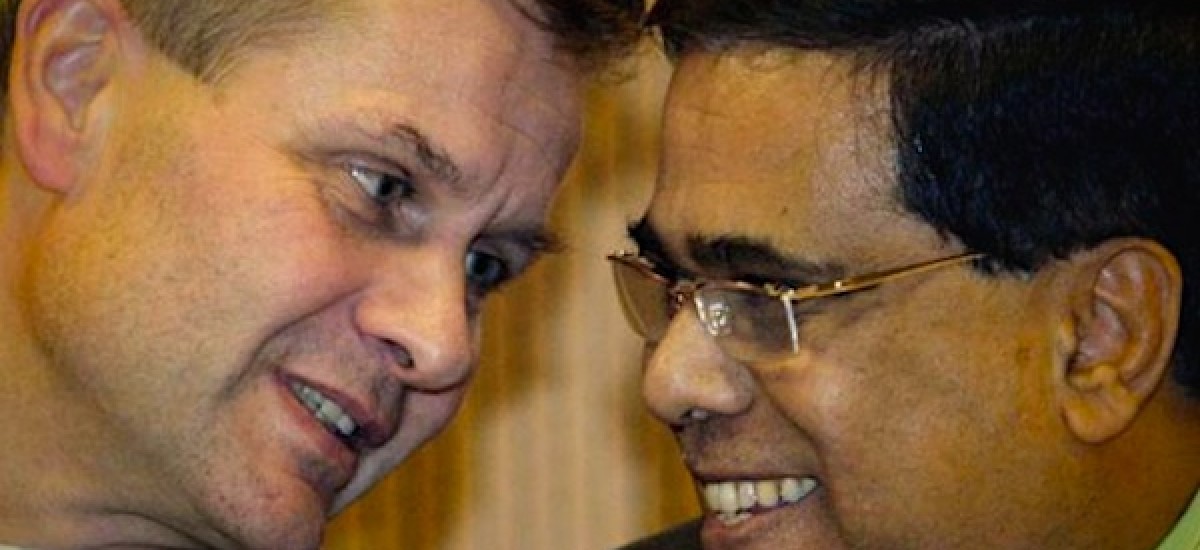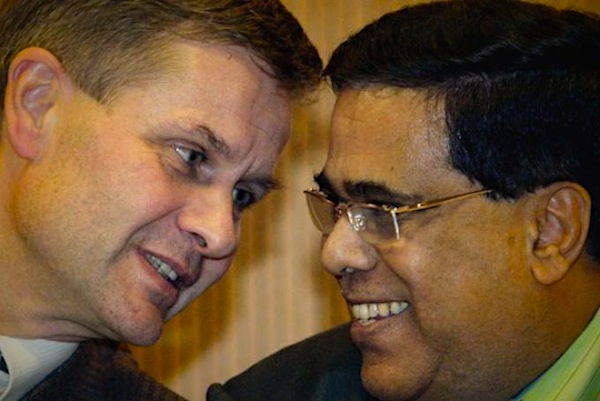Norwegian Development Minister Eric Solheim with Minister Nimal Siripala De Silva. Image courtesy Colombo Telegraph
Norwegian peace efforts in Sri Lanka have been the subject of heated debate and controversy, ever since they became public in December 1999. This debate has spawned many different stories about Norway’s involvement in Sri Lanka, some of them very critical. The evaluation entitled “Pawns of Peace”, which is presented in Oslo today, attempts to provide a systematic and comprehensive overview of Norway’s role as a mediator, as well as a ceasefire monitor and aid donor, from 1997 and 2009.
Based on a combination of interviews with key protagonists and archival research at the Norwegian Ministry of Foreign Affairs, our report provides a detailed narrative of the rise and fall of the peace process and it draws conclusions and lessons about Norway’s involvement. The report criticizes several aspects of this involvement, but it also underscores that the tragic story of Sri Lanka’s peace process and the resumption of war that followed was no more about the Norwegians “failing”, than it was about the government “winning”, and the LTTE “losing”. Norway made mistakes and its intermediate successes – the ceasefire, the “Oslo Declaration”, the joint mechanism for tsunami aid (PTOMS) – proved ephemeral, but it is unlikely that a different mediator, or a fundamentally different type of intervention would have had an altogether more positive impact. After all, the structural characteristics of Sri Lanka’s minority conflict, its political system, the nature of the LTTE, and shifts in the international context were of determining importance for how the conflict – and the peace process – evolved.
The peace process reproduced, rather than transformed underlying structural obstacles to conflict resolution. It failed to induce fundamental changes in the disposition of the state and anti-state formations in Sri Lanka, and to some extent it caused a further entrenchment of positions. The hurting stalemate which led to the Ceasefire Agreement, initial peace talks and a period of ‘no war-no peace’, was followed by an escalating shadow war and finally open hostilities ending in the defeat of the LTTE in May 2009. Many factors contributed to this train of events, but the following were crucial.
First, both the government and the LTTE entered into the peace process while staying committed to their cause. That is not to say they were not genuine in exploring a political solution, but neither party made any significant shift in how they defined that political outcome; there was an incommensurable gap between what the south would countenance (a unitary state with limited devolution) and the LTTE demanded (a separate state in all but name).
Second, peace efforts were constrained by structural features of the Sri Lankan state and politics. The conflict is understood here as being rooted in processes of incomplete state formation, which led to competing ethno-nationalist projects. Conflicts over territory are particularly resistant to negotiated settlements. Several features of Sri Lankan politics made the challenge even harder including dynastic and inter-party rivalries, patronage politics and nationalist mobilization which resisted state reform and foreign interference.
Third, the window of opportunity for a negotiated settlement was only a short one and based upon a unique constellation of domestic and international factors – including a hurting stalemate, leading to an acceptance by both sides of a measure of military and political parity, a Western oriented government and multi-faceted international backing for negotiations. These factors were to change relatively quickly. Perhaps most importantly, the 2004 split in the LTTE shifted the military balance decisively in the government’s favour. This decreased incentives for substantive concessions by both sides. Policies associated with the war on terror, rather than concerns for the specificities of the Sri Lankan case, undermined the potential for LTTE transformation and increased the isolation of Norway as the sole state conduit to the organisation.
Fourth, there were important changes in the international positioning of the Sri Lankan government. The effort led by the United National Front (UNF) government to internationalize the peace process through security guarantees, donor funding and politically sensitive economic reforms sparked a Sinhala-nationalist backlash. This contributed to the emergence of a nationalist-oriented administration, with a commitment to a more hard line position towards the LTTE and greater scepticism towards Western involvement. The new administration constructed its own version of an international safety net, by drawing on the financial support and diplomatic cover of Asian powers. This allowed the Rajapaksa government to pursue an ultimately successful military ‘solution’ to the conflict.
As a weak, soft power mediator Norway was not in a position to counter or transform these dynamics. In the absence of a strategic road map, or a robust network of international actors, the peace process failed to lock the parties into irreversible concessions and commitments. To some extent this can be attributed to limitations of Norway’s ‘ownership’ model, which provided both parties with the space to avoid core political issues, while continuing to pursue incompatible goals.
Many of the constraints identified above were not amenable to external mediation and it should be recognized that all actors were operating in an environment of great turbulence and with incomplete information. However, different courses of action by Norway might have mitigated some of these problems. First, a stronger understanding of the domestic context, particularly an appreciation of the material and symbolic effects of external intervention, would have helped the team to predict many of the dynamics sparked off by the peace process. Second, the rather passive, ownership-based model left Norway open to instrumentalization, and this could have been addressed by placing stronger parameters and minimal conditions on the Norwegian involvement from the beginning. Third, a careful monitoring of such parameters should probably have led to Norway withdrawing from its roles as mediator and monitor at an earlier stage.
Norway’s experience in Sri Lanka yields some broader lessons for peacebuilding elsewhere:
- Peace processes produce unforeseen and unintended consequences. Mediators need to consider the potential costs of their actions. Applying a consequentialist ethic and precautionary principles are required, including benefit-harm analysis and the careful and continuous weighing of possible scenarios and outcomes.
- There is a need to think about the balance between hard and soft power. Norway’s approach may be suitable to bring parties into negotiations, but harder forms of leverage may be required to reach and implement a settlement. Even so, as shown by the Sri Lankan experience, hard power deployed by external actors cannot override domestic political dynamics when the constituency for peace is weak or limited. Norway should avoid situations where it is a weak and isolated mediator, with limited and inconsistent international backing. This means placing more attention on ‘multilateralizing’ peace processes by building links to, and borrowing the leverage of other more powerful actors and coalitions.
- There is a strong rationale for an ownership approach but this does not negate the need for clear parameters of engagement. Without sacrificing the basic idea of ownership, there is a need for mediators to attach firm conditions to their involvement, including the right to engage with all parties deemed to be relevant; preserve public communication channels to speak out against malpractices or defend either the process or themselves; and maintain or acquire leverage in relation to the parties.
- Aid may play a supportive role in peace processes, but cannot short circuit complex political processes. Aid cannot be a substitute for politics. Moreover, poorly conceived aid has the potential to destabilize fragile political settlements. In Sri Lanka at one end of the spectrum, working ‘on’ conflict sometimes amounted to trying to ‘buy peace’. At the other end, economic reforms were based on a simplistic understanding of the relationship between economic efficiency, growth and peace. It is in the middle ground between these two positions that aid is most likely to play a supportive role in the pursuit of peace. This necessarily involves a more modest but conflict sensitive role for aid in the context of peace processes.
- Norway played several roles in Sri Lanka, not all of them easily compatible with one another: these included diplomatic broker, arbiter of the ceasefire, and humanitarian and development funder. Norway’s experience in Sri Lanka underlines that when multiple roles are combined, there is a need to develop a more robust strategic framework which optimizes synergies and complementarities between them. Otherwise tensions and trade offs are more likely, particularly in the context of an unconditional ownership approach and a flimsy international framework.
- Norway has usually been a mediator in conflicts between a state and non-state actor, based on an approach of even-handedness and addressing issues of asymmetry. The Sri Lankan case highlights the difficulties of following such an approach in the context of the war on terror. This suggests a need for careful reflection on whether it is possible for Norway to square the circle of showing a united front with other international players on countering terrorism, whilst attempting to talk with ‘terrorists’ in order to bring peace.
- The Sri Lankan peace process reflects broader global changes. It began as an experiment in liberal peacebuilding and ended as a result of a very different ‘Asian model’ of ‘conflict resolution’. Building on Westphalian notions of sovereignty and non-interference, a strong developmental state, the military crushing of the ‘terrorism’, and the prevalence of order over dissent or political change, this model may serve as an inspiration for other countries in the region. This global ‘eastward’ shift may have far-reaching implications for the possibilities of Norwegian-style mediation in the future.


